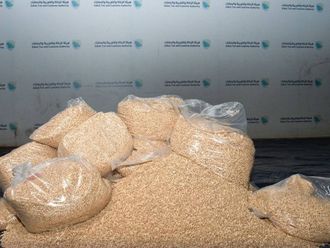
Manama: When US President Donald Trump on April 7 ordered the firing of 59 cruise missiles at a military target in Syria as a swift retaliation for their use of chemical weapons on civilians, several Saudis warmly welcomed his decision.
In fact, Nawaf Al Assi, a folklore poet, was so elated with the strike that he composed six verses thanking Trump for the attack. Al Assi turned the verses using a Bedouin dialect into a ‘shaila’, a type of desert chant that was famous mainly among nomads before it gained greater popularity in urban areas thanks to social media.
The shaila is often a statement of praise or glory for the tribe or a message rendered in chanted rhyming verses without the use of any musical instrument.
However, recently some Saudis have started adding music to make it more appealing to the general public.
Today, on roads, in cafés, in stadiums and in schools, Saudis hear shailas being played by shop salesmen, drivers, fans and students.
In some areas, young men park their cars on the side, turn on the stereos and engage in the traditional dance on the rhythms of shailas, often described as a form of desert rap.
The sight reflects a new trend among Saudis who, after years of listening to more refined music composed by well-known Saudi or Gulf musicians and performed by famous singers, seem to have reverted to a type of entertainment closer to the concepts of their forefathers.
Even the leading football clubs in Saudi Arabia have had shailas praising their players and their achievements.
In the past, these clubs could not be content unless the most prestigious singers paid musical tribute to their glory.
Several religious scholars refused to ban shailas as long as there was no music to accompany the performers.
However, some schools in Riyadh have been very strict about shailas, banning them and warning students in a bid to curb the phenomenon. The schools argued that some of the expressions used in shailas were offensive and racist.
“Are we witnessing a new trend that indicates new moods among the people or is it a normal volte-face and an earnest desire to reconnect with the desert and its embracing culture?” asks Abeer Al Ebrahim, a journalist with Saudi daily Al Riyadh. “Or maybe it is a withdrawal from the city and its noisy atmosphere that cannot be tolerated by everyone?”
Saudi literature and art critic Dr Mujab Al Adwani said that shaila is part of the folklore and relies on the oral transmission of words and short poems.
Flash mobs
“It has now entered the popular culture but under a new format,” he said, quoted by Al Riyadh daily. “It has become a cultural product that features short poems recited much faster in unison by a group of people often without a musical instrument. However, the topics have not really changed and the poems are dominated by praise and self-glory and an exaggeration in describing homesickness for some places.”
However, Al Adwani added that shailas as such will be like flash mobs that will disappear after some time.
“Such phenomena that strongly emerge at particular periods of time and are closely related to social variables will soon fade away. They lack the depth of heritage that gives them originality. They also seem unable to evolve in their musical composition and tend to be mere repetitive patterns. As such, they do not have the characteristics of real art. In addition, the absence of an audience that feels strongly about it remains a huge obstacle.”
Another Saudi critic, Dr Marzooq Bin Tinbak, attributed the revival of shailas to a reversion to the local folklore and to the absence of other cultural options.
“There are no real options for young men who are really good only at such types of chanting to express feelings,” he said. “Shailas offer a good chance because they are made up of easy words and rhythmic chanting that stir emotions. Social media have also played a significant part in expanding the circles of people who heard, then listened to shailas, and thus increased its popularity.”
The critic however believes that the phenomenon will slow down and lose its appeal.
“Like so many other phenomena, it will fade away and people will be interested in other forms.”
For critic Mohammad Al Herz, shailas are an important component of the local culture, rituals and traditions.
“The problem is that shailas are being used in a way that impacts social and cultural relations,” he says. “When the populist factor is stronger that the cultural and social factors and people look at everything and everyone through that prism, then we have a serious problem. People no longer accept others as equals and think of themselves or their tribes or groups as on higher grounds and this consolidates differences within society.”
Al Herz warns that such a subculture can be resisted by promoting social awareness through other cultural activities.
“I am now more optimistic following the establishment of the General Entertainment Authority which will face some difficulties at first, but will eventually balance between folklore and other types of entertainment,” he says.
The General Entertainment Authority, a government-sanctioned body borne out of Vision 2030, is tasked with developing, promoting, regulating and funding a competitive entertainment infrastructure in Saudi Arabia through partnerships with public agencies and the private sector.
“If there were periodic celebrations, whether weekly or monthly, the shaila would not have achieved the status it has today,” Al Herz says. “The shaila has always existed, but it has expanded because there are no other cultural activities and also because of the social communication media.”












